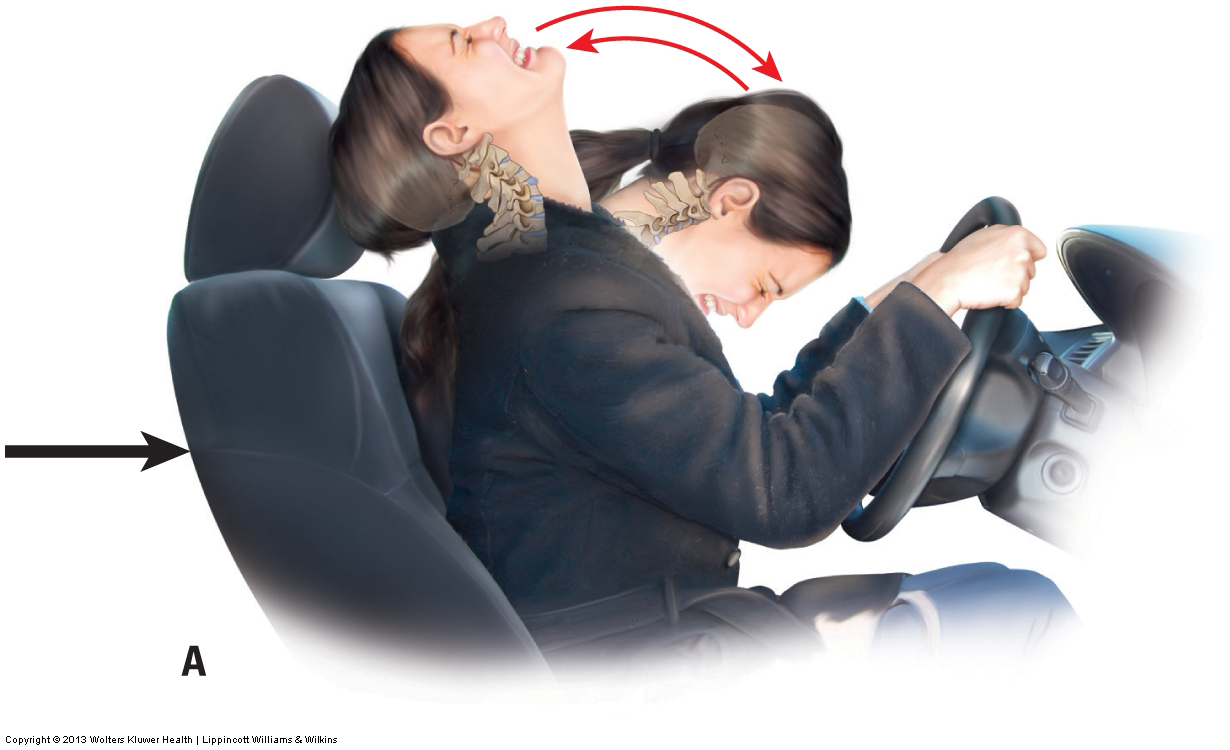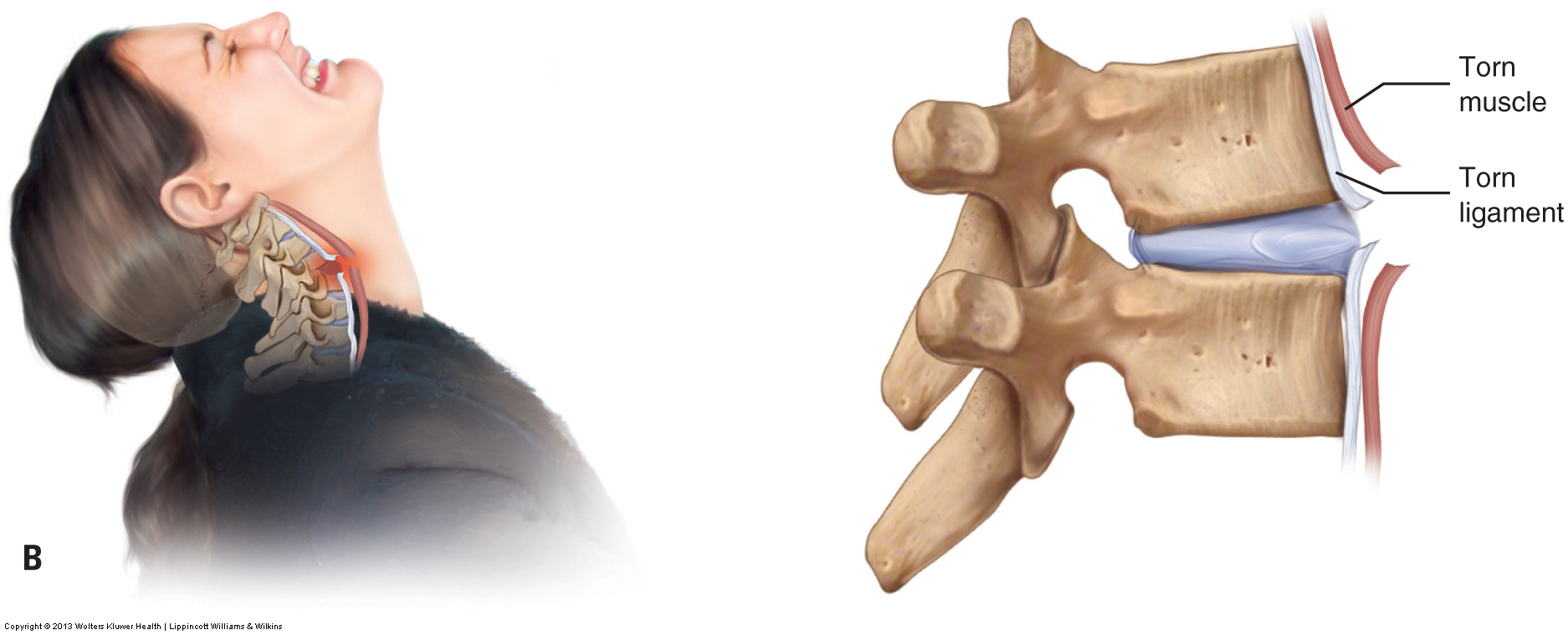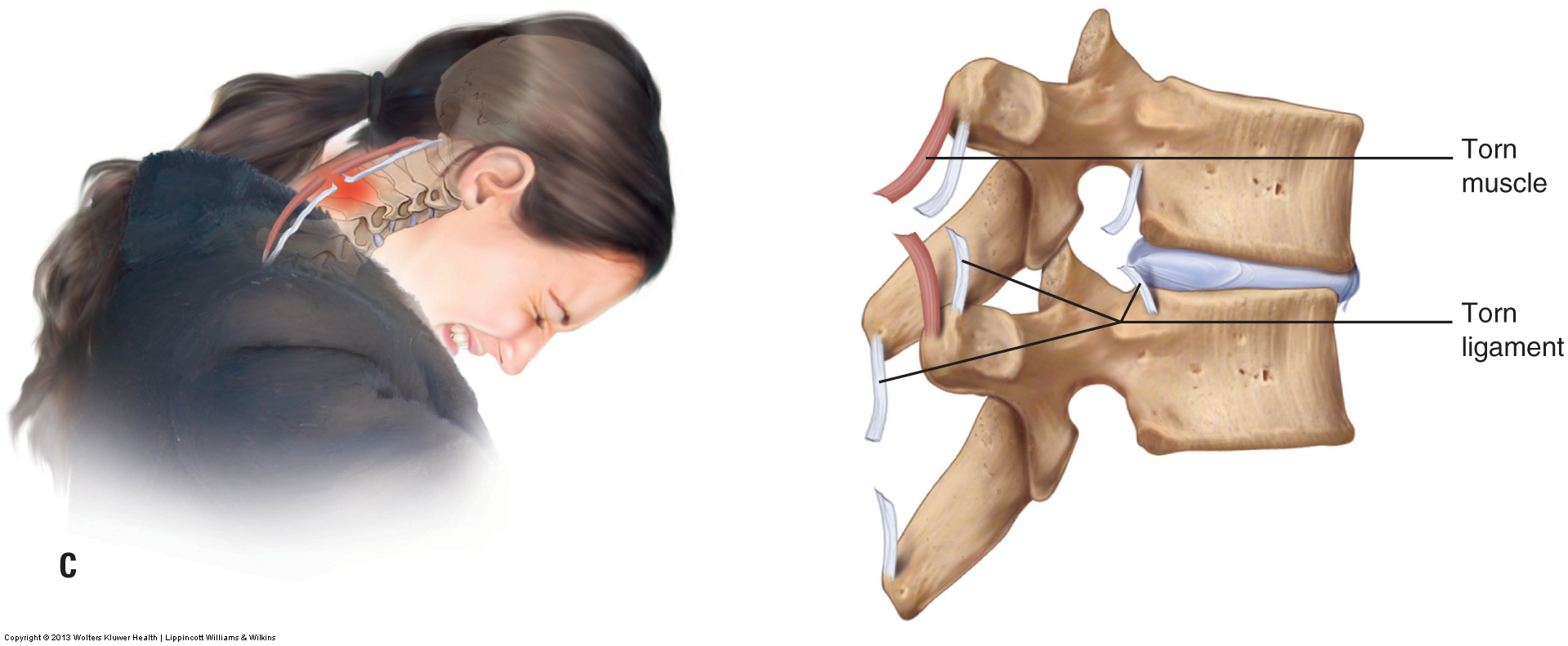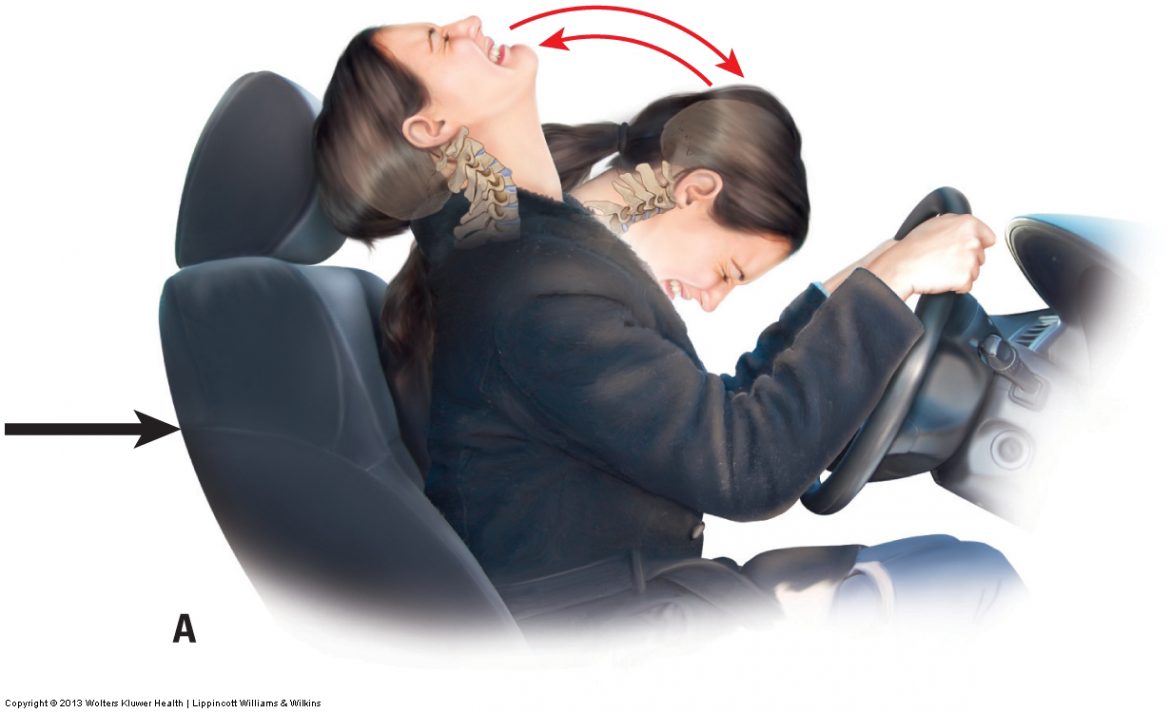Sprains and strains of the neck are usually addressed together because they are similar in nature. Technically…
- when a ligament or joint capsule (fascial tissue) is torn, it is termed a sprain
- when a muscle is torn, it is termed a strain

Description of Sprains and Strains
Sprains and strains tend to occur together because the force that is necessary to tear one tissue will likely cause tearing of the other. However, sprains and strains are not always equally present. An injury may present as a minor sprain but be a major strain or vice versa.
The severity of a sprain or a strain is expressed as follows:
- Grade I: Minor tear
- Grade II: Moderate tear
- Grade III: Marked tear or complete rupture
The criterion most important for determining whether the largest component of the injury is ligamentous sprain or muscular strain is the position of the joint during the injury. Ligaments (and joint capsules) are taut and will be torn only at the end range of a motion; whereas muscular tissue, especially if contracted at the time of injury, can be torn at any phase of the range of joint motion.
Therefore, most ligamentous sprains occur when the neck is thrown to the end ranges of motion. Injuries that are primarily muscular strains tend to occur midrange in motion patterns.
Regarding location in the neck, the strain and sprain components will usually occur at approximately the same level of the neck.
Given that strains and sprains involve torn soft tissue, pain, inflammation, and bruising are usually present when they are in the acute stage. Muscular splinting/spasming is also present in the acute stage and often persists long-term.
Note: Is it really a strain?
The term strain is often used loosely. At times, a client who is described as having a strain actually has a muscle spasm. When a muscle is stretched too quickly or too far, the muscle spindle’s stretch reflex is initiated, which causes the muscle to contract (spasm). This reflex prevents the muscle from being torn and therefore strained. However, the resulting muscle spasm is often described as a strain (certainly, if some tearing occurred before the stretch reflex engaged, then it would truly be a strain in addition to a spasm). However, it is possible to justify the use of the term strain in this scenario from another perspective. Any strenuous use of a muscle usually results in a normal and healthy amount of microtearing of the muscle’s fascial tissue. This fascial microtearing is necessary so that the fascia can mend and heal larger. This allows for more sarcomeres and sarcoplasm to be placed in the muscle fiber when a muscle hypertrophies after exercising. Hence, this microtearing could be interpreted as a minor strain of the muscle. The most important point is to understand the mechanism of what is occurring so that treatment is appropriate for the condition.
Although sprains and strains are similar, functionally they present quite differently. Sprains are worse than strains because ligaments lack a good blood supply and therefore do not heal well. For this reason, once a ligament has been stretched and torn, it usually heals stretched out and remains that way for the rest of the client’s life, resulting in chronic joint hypermobility. Musculature, on the other hand, has a good blood supply, so strains usually heal well if properly treated. However, the presence of a good blood supply also causes more bleeding and bruising with strains. Strains also usually hurt more than sprains because muscle tissue has more sensory nerve endings than ligaments.
Mechanism and Causes of Sprains and Strains
The mechanism for sprains and strains is similar. An excessive pulling force causes a disruption of the fibers of the ligament or musculature. This pulling force can occur during a macrotrauma, such as the whiplash of a car accident. It can also result from repeated postural or movement microtraumas, such as overuse injuries that place excessive tension on ligaments and muscles over time (Fig. 10).
Figure 10. Overuse postural stress on the myofascial tissues of the posterior neck. Originally published in the massage therapy journal (mtj): seven keys to healthy neck posture: spring 2010 issue.

The function of a ligament is to limit motion of a joint; therefore, if the ligament is torn and stretched, the joint tends to become hypermobile and less stable. This may be masked during the acute phase by muscular splinting/spasming. Strains, on the other hand, tend to result in joint hypomobility, both because of muscular spasming that occurs in the short run and often continues into the long run, as well as the formation of scar tissue adhesions that occur during the healing process. Although adhesions are necessary to repair and mend torn soft tissues, if excessive adhesions are allowed to form, the tissue will lose its mobility, resulting in decreased ranges of motion.
Whiplash
Whiplash injuries are named for the characteristic whiplike motion of the person’s head and neck during a car accident. For example, when a person’s car strikes an immovable object or another car in front of it, the person’s head and neck are thrown forward and then backward, similar to how a whip lashes forward and pulls back. The excessive lashing forward causes hyperflexion of the neck; the excessive lashing backward causes hyperextension of the neck. For this reason, a whiplash injury is often described as a hyperflexion/hyperextension injury (although if the trauma occurs from the side it would technically be a hyper-lateral flexion injury, and if spinning of the car were involved, it could be termed a hyper-rotation injury). Automobile accidents at a rate as slow as 5 miles per hour can cause whiplash accidents. The neck may also experience the equivalent of a whiplash injury without an automobile accident. Sports injuries and everyday twists and falls can result in a similar whiplash trauma to the neck.
Whiplash causes an overstretching and/or tearing of soft tissue. Overstretching triggers the muscle spindle stretch reflex to occur, resulting in spasmed muscles. Consistent with the general use of the terms, if tearing of muscular tissue occurs, it is termed a strain; if ligaments are torn, it is termed a sprain. The sprain component is often the more severe of the two, resulting in a loss of stability of the neck (Fig. 11).



Regarding the sprain component, depending on how the neck is thrown during an automobile accident or other injury, different ligaments can be sprained. For example:
- If the neck is thrown anteriorly into hyperflexion, posterior ligaments are torn, and the neck will be hypermobile in flexion.
- If the neck is thrown posteriorly into hyperextension, anterior ligaments are torn, and the neck will be hypermobile in extension.
- If the neck is thrown laterally into right lateral flexion (hyper right lateral flexion), ligaments on the left side of the neck are torn, and the neck will be hypermobile into right lateral flexion.
- If the neck is thrown into right rotation, ligaments that limit right rotation can be sprained, causing hypermobility into right rotation.
- Of course, the whiplash motion is not always perfectly in a cardinal plane; and may instead occur in an oblique plane, which is a combination of two or all three cardinal planes. This could result in a combination of sprained ligaments.
Note: Treatment Considerations in Brief for Neck Sprains and Strains
Icing is especially useful for treating acute strains and sprains. Massage is helpful for sprains and strains when the condition is subacute and/or chronic. Stretching is helpful for subacute and chronic care of strains. Stretching and joint mobilization is contraindicated for any unstable/hypermobile tissue, which chronic sprains may create.
And, as a general rule, with any manual therapy treatment to the neck, there are always precautions and contraindications to consider given the number of sensitive structures present.
Click here for a blog post article on assessment and signs and symptoms of low back sprains and strains.
Click here for a blog post article on manual therapy treatment of low back sprains and strains.
Note: This blog post article is the fourth in a series of 10 posts on
Common Musculoskeletal* Conditions of the Neck
The 10 Blog Posts in this Series are:
- Fascial Adhesions (and an introduction to musculoskeletal conditions of the neck)
- Hypertonic (tight) musculature
- Joint dysfunction
- Sprains and strains
- Pathologic disc conditions
- Osteoarthritis (OA)
- Thoracic outlet syndrome (TOS)
- Forward head posture
- Tension headaches
- Greater occipital neuralgia
(*perhaps a better term is “neuro-myo-fascio-skeletal”)


